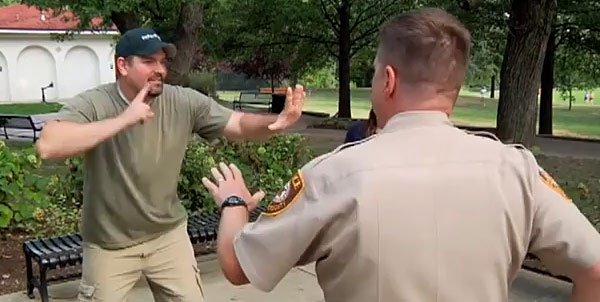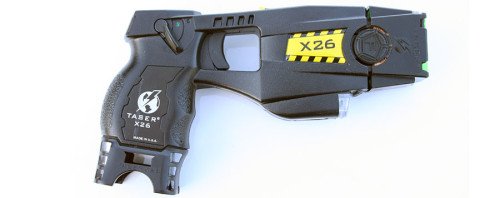Recently the Police Executive Research Forum (PERF) published 30 Guidelines identifying its recommendations for every American law enforcement agency to better handle the highly volatile topic of police use of force. In our first article, Part I, we discussed the guidelines that made sense and actually can assist law enforcement in effective interactions with the public in general and with violent or mental suspects.
However, among the 30 Guidelines PERF presented are some incredibly short-sighted recommendations that could very well endanger police officers and the public. This article will discuss those guidelines, and how they could be counter-productive to the intended goal of making the profession better and the public safer.

EDITOR’S NOTE: This is Part II of a three-part series on the Police Executive Research Forum’s recent publication of 30 Guidelines for American law enforcement executives to accept in what PERF has described as a model approach to the recent surge in public debate on police use of force. The first article covered the Guidelines that we feel are “Good”, and should help any agency or officer better carry out their duties. This article will cover the PERF Guidelines we feel are “Bad”, at least in part, to professional police services. The final article will cover the PERF Guidelines we feel are “Ugly”, and could create chaotic disruption to established legal precedence and nationally accepted police practices.
PERF – A Top-Down Organization
We’ve previously noted that PERF’s goal is to change and dictate executive level decisions and policy to America’s law enforcement Chiefs and Commanders. It is understandable to try to make changes at the top, where policy and directives can be instantly changed. It is also necessary to recognize that executives are far removed from the realities of the street. It is easy to sit in boardrooms making sweeping decisions with buzz words. It is an entirely different animal to be fighting for your life with a committed adversary who may be bigger, stronger, or drug influenced.
When making changes from the top, organizations like PERF often lose sight of what is practical, safe, and allowed by the law to effectively police America’s streets. Chiefs, commanders, and police policy think tanks (like PERF) are often so removed from the reality of the streets, their influence comes from the emotional standpoint forwarded by the ignorant, rather than the seasoned response of a veteran professional.
The Bad
Unfortunately, PERF establishes some Guidelines that are highly controversial, and short-sighted. Some Guidelines are completely contrary to best practices for officer safety and conflict resolution. These guidelines can actually prolong a critical incident (in a bad way), and places the safety of the suspect over officers and community. This type of guidance is reckless and unsound, both legally and morally.
The following Guidelines fall into the “Bad” category. Though the Guidelines might have been well-intended, and actually contain some good potential, there is so much room to twist them into the “bad” that they cannot be allowed to stand as is:
- Agencies should adopt a critical decision-making model (or matrix).
The Critical Decision Making Model is a very good idea, and should be discussed within any police agency or training Academy. The ability to evaluate the circumstances, consider all available information, make decisions and act upon them, and then evaluate the results to determine the next course of action is an excellent process. Teaching officers to constantly evaluate a situation, and evaluate the effectiveness of techniques is very appropriate.
However, this model is also generic enough it is very difficult to implement in rapidly evolving and violent situations. Those incidents often require officers to act on immediate information and dangers. The situations often do not allow a calm and detailed reflection to evaluate the effectiveness of decisions and prior actions when officers are attempting to contain or restrain violent subjects in close proximity.
However, a Critical Decision Making Model is an excellent tool for absent commanders to scourge an officer’s decisions and actions after the fact. Without considering the volatility and rapidly evolving nature of these most critical incidents officers must face, the Model could quickly be used to point out supposed flaws and better courses of action the are only revealed with reflective after-thought. In addition, since the Model presents a well-designed and wise approach to working problems, it becomes self-fulfilling in its condemnation of an officer’s split-second action. In essence, the Model has shown a better way, and because the Model is so sound and wise, you – the officer – must be wrong.
- Shooting at vehicles strictly prohibited.
To be fair, the PERF Guideline states to prohibit shooting at vehicles when the vehicle is the only weapon. In many situations this restriction is completely appropriate, and should be an emphasized policy and tactic in modern policing. Officers should be trained to get out-of-the-way, let the suspect pass, and then attempt stopping techniques later.
When officers do nothing to place themselves in danger, but the suspect uses their vehicle in a direct manner to place them in immediate threat of serious bodily injury or death. In a very narrow set of circumstances, officers should still have authority to use deadly force at, into or from a moving vehicle. The policy should be crystal clear, recommending every attempt be made by the officer to avoid getting in the path of vehicles, but when unavoidable and their life is in peril let officers reasonably use the force necessary.
Remember, the U.S. Supreme Court does not find this action unlawful or unreasonable in terms of the 4th Amendment. We should be very wary in limiting viable options the highest Court in the land has found to be justifiable and reasonable in certain circumstances.
This Seattle Police incident is a perfect example of when shooting at vehicles is not only legal but appropriate to stop the threat to officers and the community. After brandishing a handgun in at least two businesses, and then carjacking more than one vehicle, this subject led police on a high-speed pursuit in crowded urban streets. The subject fired on officers more than once, endangering the officers and the surrounding community. When finally cornered, the suspect did not surrender, but instead began driving his stolen Camaro in a highly aggressive manner towards officers. According to PERF, the officers should have allowed this violent felon to crash through their vehicles and continue on his path of destruction through the community. We disagree. The Seattle Police responded appropriately, lawfully, and morally ending this threat.
Completely eliminating this option from the officers lawful decision-making allows the law-breaker an option to continue their violent behavior with severely limited response by officers. This should not be taken lightly, but a policy should clearly state that if the officer’s life, or another’s, is in immediate danger from the vehicle and there are no reasonable alternatives, the use of deadly force from a firearm will still be allowed.
- Prohibit deadly force on those who pose a danger only to themselves.
Absolutely! The sanctity of life should be held in the highest regard, and this guideline actually goes hand-in-hand with the concept presented in Part I – the Priority of Life. In most circumstances involving suicidal subjects, officers rush the situation trying to stop the person from harming themselves. Too often these noble, but incorrect actions, are confronted with a desperate person’s actions that constitute a lethal threat (gun, knife, etc.). When lethal force is used in these circumstances it becomes what internationally renowned use-of-force expert, Major Steve Ijames (ret.) calls “Lawful but Awful”. It truly is awful, and tragic, and police agencies and officers should do everything in their power to avoid these situations.
The Priority of Life scale places suicidal subjects at #4, below officers at #3. This doesn’t mean their lives are not valuable, it simply means that as a practical guide it makes no sense for officers to place themselves in a situation that the suicidal subject becomes a lethal threat. This is more easily accomplished when the suicidal subject is contained within their own residence, or at least out of the public. Yet, even in public, officers can use containment and cover to provide opportunities for negotiation or less lethal options to resolve the situation.

However, the PERF Guideline seems to blindly dictate that a suicidal subject is suicidal and only suicidal. We must understand that some suicidal subjects become homicidal. People suffering extreme mental distress can often turn homicidal in a response to the circumstances they feel are so unfair or the pain and anger they feel. In those situations, regardless of where they started, or the history surrounding their problems, lethal force may become necessary to protect officers or citizens. These situations can change in a flash, and although always tragic they are perfectly legal and moral.
Here a “suicidal” subject creates a clear and present danger to officers and the public. The ultimate decision for this outcome rests completely with this individual – NOT the officers who responded to his call. Even if his ultimate goal was “suicide by cop” the officers performed their duty while being placed in this miserable circumstance.
There have also been many times a suspect who has committed horrible crimes (murder, rape, child offenses, etc.), is confronted by police only to suddenly threaten suicide. It is a desperate attempt to thwart the officers attempts at apprehension, and to provide them time to think and plan. These individuals are extremely dangerous – to themselves, the public, and the officers. They are literally like a caged, wild animal. If they present a lethal threat, the use of lethal force against them should be well-considered well within the realm of acceptability.
- Eliminate the “21 foot rule” with Distance, Cover, and Time.
The elimination of the “21 foot rule” is unnecessary. What is necessary, however, is the correct application and teaching of the actual testing from decades ago. What started as a very good, and valid, training topic has been muddied and morphed into a mystical circumstance that hardly resembles the original concept. Misunderstandings have turned the “Rule” into something far more heinous than it was originally intended to teach, and absolutely wrong in some cases.
The original “rule”, as demonstrated by Salt Lake City trainer Dennis Tueller, demonstrated a suspect armed with a knife could reach and successfully attack an officer 21-feet away, before the average officer could recognize the threat, unholster their sidearm, and fire (2) center mass hits on the assailant.
The concepts and purpose of the “21-foot Rule” are displayed very well in this video. The conceptual reality that action is always faster than reaction is made painfully clear here. The original study found that 21-feet was the approximate distance an average officer could recognize the threat, draw their sidearm, and fire at least two center-mass shots before the attacker could reach them and inflict damage. For this reason this “rule” and concept should still be taught.
These tests were conducted with a trained attacker from various distances away from an officer who had a holstered sidearm, and without any kind of intermediate barrier. The important concept was for officers to be aware of their surroundings and recognize that open area, and short distance, provides far less reaction time than might be originally thought. At the same time being 21-feet away from a suspect is not an automatic indicator of immediate threat. Intermediate barriers, exit paths, restrictive pathways to officers, and less lethal weapons can all alter the actual threat at 21-feet.
The PERF recommendation to replace this concept with “distance, cover, and time” should actually be combined with the concepts of the correct 21-foot Rule. Cover and distance allow an officer more time to reflect on the situation and make better decisions. Decisions made outside of the immediate response to close proximity deadly threats.
By combining the understanding that 21-feet is not necessarily enough distance, and the concepts of find cover, create distance, to provide officers more time, the profession gets the best of both worlds. The “Rule” should not be eliminated, it should be taught correctly and in combination with the tactics of distance and cover.
- If an ECW doesn’t work don’t immediately go to firearm.
PERF’s perfect world seems to always have a less lethal option readily available to officers to solve the real world problems blanketing the media headlines. In reality, electronic control weapons (ECW) fail frequently because the prongs don’t attach properly, or the person is under the influence of drugs or alcohol. This much is true. What PERF apparently refuses to acknowledge is the fact these failures of the ECW are most often in close proximity to the suspect, often much closer than 21-feet that we have already discussed (Taser’s current maximum range is 25 feet).
Standing in stark contrast to their own previous Guideline to create Distance, Cover, and Time, ECW’s require officers to get into close proximity of the suspects. All too often this less lethal option requires officers to be exposed (away from cover), eliminating the desired element of more time to make observations, evaluations, and further decisions.
The PERF Guideline does not abandon the ECW, but demands going to other less lethal options first. If there happens to be multiple officers on scene, this may be feasible. When officers are alone, the options quickly fall by the wayside. Ultimately, distance and the actions of the offender will dictate the course of action.

When an ECW fails to work, some suspects will begin to comply, and are taken into custody with little further use of force. Others will amp up their resistance, and become even more physically violent. An ECW is sometimes attempted on a suspect armed with a knife, or blunt force object. If a deployment fails in those circumstances, and the offender increases their violence, there is an immediate threat to the officers or community. The use of lethal force in those circumstances can be appropriate, lawful, and moral.
When a less lethal option fails, and the suspect continues or increases their violent response, there is often precious few moments to evaluate and determine the next best course of action. More likely, officers are actively engaged in a very tense, uncertain, and rapidly evolving set of circumstances. Sound familiar – Graham v. Connor. When combined with the offenders possession of a weapon, officers should not be handcuffed from using lethal force to protect themselves or others.
Final Thoughts on the “Bad”
The “Bad” Guidelines PERF has presented, could easily be placed in the “Good” column with some modifications. There is some real merit to many of the concepts, but the improper application by over-zealous Commanders is where failure is found. Officers should be provided clear direction, established boundaries, and rules that make sense.
When seeking to make broad changes in police procedure there must be something much more compelling than simply conjecture by the media or some civic groups. Police use of force should be closely watched and investigated. Training officers to communicate, attempt de-escalation, and using less lethal options first is sound and wise direction. However, placing Guidelines in place that appear completely incognizant of the realities of the immediate violent encounter are not only unsound but dangerous.
The highest court of the land has consistently ruled to gauge officers actions based upon the totality of the circumstances, and the reasonableness of the officer’s actions based upon what threats they faced. Police executives should provide more training, and less lethal tools to their officers, not more restrictions.
Some of what PERF is pushing can be explained in the organization’s evaluation of foreign police forces. Recently PERF hosted several major American police department commanders on a trip to Scotland. The Scottish response to violence is to withdraw, use intermediate barriers, and then use multiple less lethal options. The Scots have not lost a constable in the line of duty for over 20 years, that one being a stabbing. The Scots have also only killed two citizens in two decades.
Though this model should immediately garner interest in determining how the Scots achieve those numbers, a quick look at several training videos and actual police altercations quickly shows that the Scottish model could only reasonably be achieved in the most populated cities. In each encounter there are already multiple Scottish officers on scene, and in one machete wielding incident, over 20 officers were ultimately involved in the take down.
The United Kingdom is much smaller than the United States, which allows police forces to be much more concentrated. That kind of manpower could only reasonably be achieved in the largest metropolitan cities in America. We’ll talk more about this influence on the PERF Guidelines in Part III.